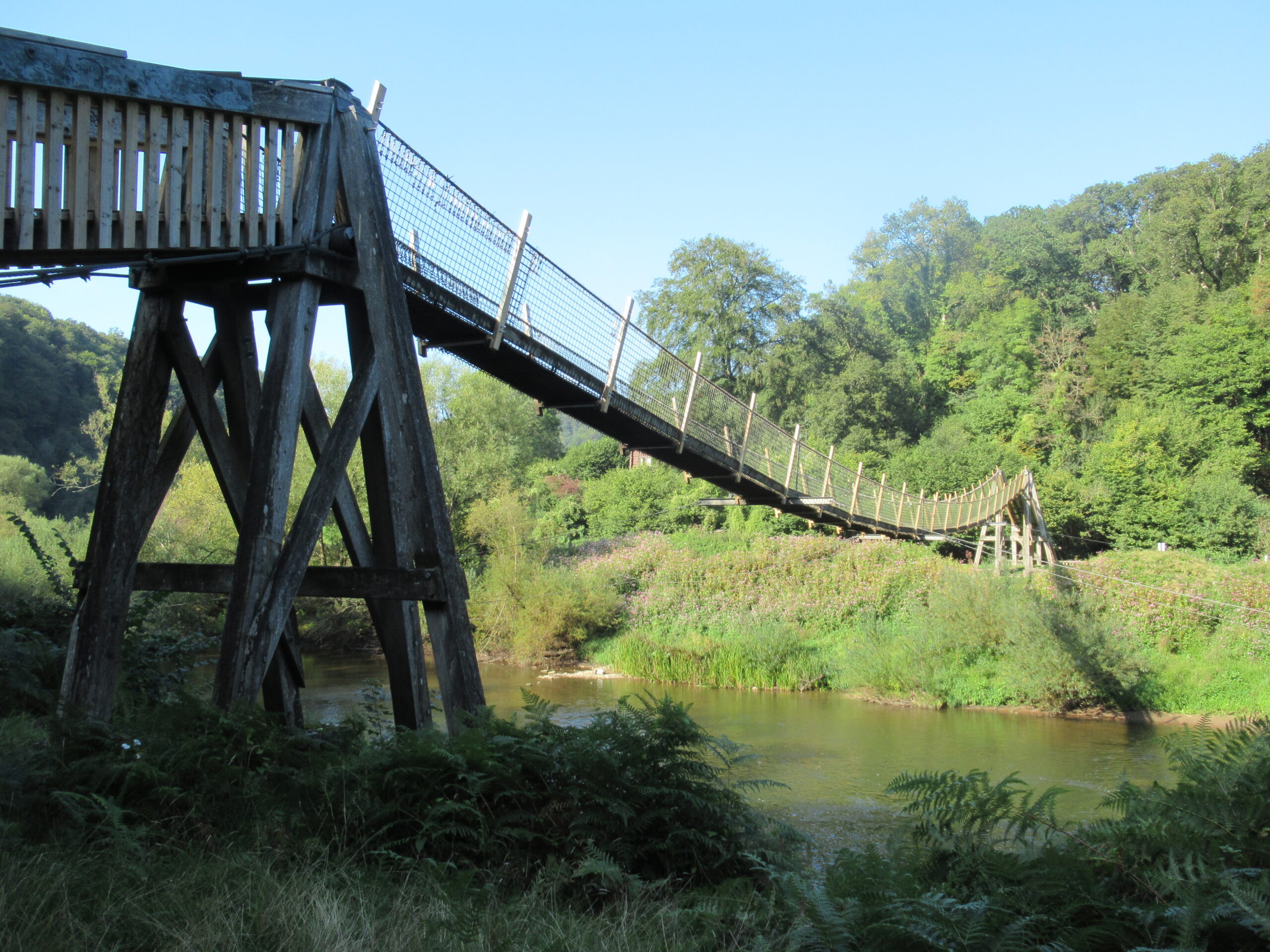This morning’s taxi back from Tintern to Cleddon has a punctured tyre, so Kate of Celtic Trails, luckily based in Tintern, is our chauffeur back up the frighteningly steep and narrow lane. As we pass through Llandogo we spot the two elderly backpackers we saw yesterday, the Couple from Chepstow. At Cleddon our old friend A. is waiting for us. He’ll will be with us for three days, carrying all his belongings on his back, unlike us softies. It’s misty, but with the promise of better weather ahead.
As we set off towards Cuckoo Wood we pass, unseen, Cleddon Hall. Then called Ravenscroft, it was the early home of Bertrand Russell. He remembered an idyllic childhood. His parents were bohemian atheists who lived in a ménage à trois with one of Russell’s tutors, and they let him wander wherever he wished.
We’re walking on a broad track through woodland. The going is easy underfoot, compared with the first day, soft and unstony. At Pen-y-fan we emerge into open country (a ‘Green’) dotted with houses. Once these had been modest cottages, each with a smallholding, but over time they’ve ballooned into small mansions – this area is a magnet for the affluent. The Green slopes down to Whitebrook, where there are some fine, older white houses and disused mills. Long ago this was an early industrial site, with wireworks and paper mills.
We’re now back at the river, and follow the track of the old Wye Valley Railway, passing a bucolic scene of cows standing still as statues in the water. Next we come to another ex-industrial village, Redbrook, and the Boat Inn, which we visited two years ago. It’s a centre for walkers and kayakers: we spot two people paddling on the water as we cross the old iron bridge to the other bank. The path now crosses broad meadows. On the left bank we admire the grassy fields sloping in an elegant curve towards the river, as William Gilpin did, no doubt, two and a half centuries ago.
At a water monitoring station we meet two workmen from Natural Resources Wales. They’re checking water flow in the river, with the help of a kind of miniature boat or floating drone. When we inquire about pollution they turn very cagy and claim that water quality is somebody else’s concern. Now the path narrows and we have to beware of stumbling across tree roots as we climb and dip. Two trees have been ‘decorated’ with New Agey ceramic plaques.
Now we’re approaching the point where two old railways used to cross the river: the Wye Valley line and the Ross to Monmouth line. The first was stone and has vanished, except for the approach arches – as C. says, from a distance they look exactly like a Roman aqueduct – while the second is of iron and survives. A few fishermen sit disconsolately by the waterside. Catches, it seems, are few.
Soon we find a third bridge, the Wye Bridge that crosses the road at Monmouth. By now we’re hungry, so we cross into the town, past the public school (motto, ‘serve and obey’) and the statue of Charles Rolls, to seek out Green and Jenks, a deli and favourite eating place we discovered two years ago. The original Wye Valley Walk followed the west bank of the river, but it was closed by a landslip some years ago. So we retrace our steps, recross the bridge and pass yet more playing fields owned by Monmouth School. How many rugby games, I ask C., do they need to play simultaneously? There’s no river path at this point, so we divert past a sewage plant and through an industrial estate – no decent walk should be without these – before joining the old railway track close to the river. Eventually the track diverges from the Wye, and the loud traffic noise from the A40 begins to fade. Traces of the old Hadnock railway station survive, with a large seventeenth century Hadnock Court, close by. Across the river is a much grander house, Wyastone Leys, the home of Nimbus Records. There’s no doubt we’re now in England.
An angler comes on to the path from the river. I ask what he’s caught. Nothing, he says, except for a large pike. There were no barbel, the fish he was expecting, and no hope of a salmon. Catches have declined since he started fishing here some years ago.
The valley’s beginning to narrow, and the wooded slopes are getting steeper. Biblins Bridge comes into view. We’ve no need to cross it, but we’re eager to try it out: it’s a very narrow wooden pedestrian suspension bridge, approached by ramps, and it sways excitingly as you cross. Next to the bridge is Lady Park Wood, a broadleaf woodland that, very unusually, has been left to run itself unhindered since the 1940s. Studies of it have given valuable information on the development of natural woodland, and clues to how other woods might be managed (or unmanaged) in future.
Beyond the bridge is a complex network of wires and poles, a run for kayakers, and we notice more walkers, dogs and cyclists than we’ve seen for some time. We’re approaching Symonds Yat East, and this part of the path is a broad promenade for strollers. No taxis needed today: we can flop straight away into the armchairs of the Royal Lodge Hotel.









Leave a Reply